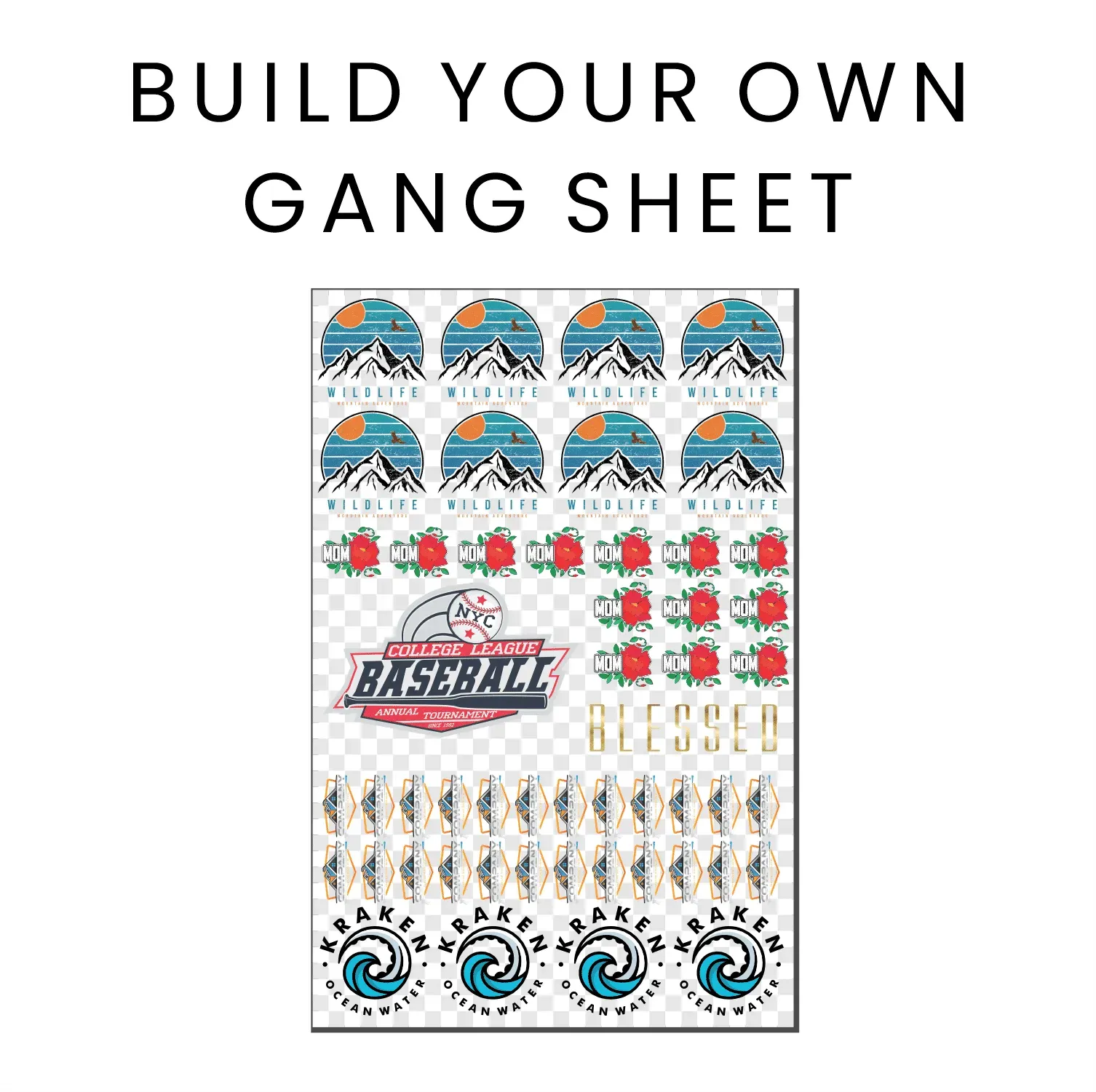DTF gangsheet builder is transforming how designers and printers approach multi-design projects, offering a streamlined path from concept to transfer. If you are new to DTF printing, this powerful tool helps you position multiple designs on one sheet, making it easier to use gangsheet templates effectively. A good DTF gangsheet builder guides you through color management, margins, and bleed, so you can master how to create gang sheets with less waste. Even beginners can leverage the platform to plan layouts, maximize substrate usage, and produce polished transfers with a repeatable DTF workflow for beginners. By choosing a solid builder and following best practices, you’ll gain confidence, speed up production, and deliver high-quality design sheets for DTF on textiles.
Think of this as a layout optimizer for batch transfers, a design tool that arranges several artworks on one printable canvas. In practice, it acts as a transfer sheet designer, helping you maximize space, control margins, and balance color across the set. For newcomers, this concept maps artwork into a grid, supporting repeatable results on a range of substrates. Templates and grids act as blueprints, enabling you to plug in new art quickly while keeping alignment consistent and reducing setup time. Adopting this ecosystem translates into faster production cycles, fewer errors, and a smoother path from concept to printed product.
1) What is a DTF gangsheet builder and why it matters for beginners
A DTF gangsheet builder is a dedicated tool or structured workflow that lets you arrange multiple designs on a single transfer sheet. In the context of DTF printing, this approach optimizes space, reduces setup time, and supports consistent color management across designs. Whether you’re working with t-shirts, tote bags, or other substrates, a well-designed gangsheet builder helps you manage layouts efficiently and accelerate learning on your first runs.
For beginners, the value is clear: predictable margins, safe printing borders, and scalable templates that you can reuse. This minimizes misprints and confusion, turning a potentially complex multi-design project into a repeatable process. By embracing a reliable DTF gangsheet builder, you align your designs with practical production steps and set a solid foundation for a scalable DTF workflow for beginners.
2) Maximizing material efficiency with gangsheet templates and design sheets for DTF
Templates play a central role in making gangsheet design fast and repeatable. Gangsheet templates provide the same grid, margins, and bleed presets across projects, which translates to less guesswork and more consistent results. When you pair templates with clear design sheets for DTF, you can quickly slot in new artwork while maintaining alignment with your printer’s capabilities.
Using templates also supports batch production. By standardizing the layout process, you can reuse the same setup for multiple products, test colors, and verify spacing before committing to a live run. This approach reduces waste and speeds up onboarding, helping even first-time operators feel confident in producing cohesive series of designs on a single sheet.
3) DTF workflow for beginners: planning and layout to optimize the gangsheet
A solid plan starts with listing every design you want on the sheet and choosing a practical maximum sheet size. Consider the transfer film’s usable area and the heat press’s working footprint, then sketch a rough diagram to map placements. This early planning step anchors the rest of the workflow, making it easier to optimize space and reduce last-minute changes in production.
Once planning is in place, focus on layout techniques that save time. Create a digital grid that mirrors the final sheet, apply a consistent scale, and use templates to jump-start each design. Practical tips include enabling snap guides for precise alignment, grouping related designs to simplify reordering, and reserving edges for color bars or branding elements. A well-structured layout supports a smoother DTF workflow for beginners.
4) How to create gang sheets: a practical, beginner-friendly step-by-step guide
Start with collecting all artwork and converting it to the correct color space required by your DTF printer. Then import designs into your layout tool and assign them to the grid defined by your chosen template. Apply margins and bleed, and add any necessary cut lines. This step-by-step method helps ensure consistency across designs and minimizes the risk of misalignment during transfer.
Export the finished gang sheet in the printer-friendly format required by your RIP software or direct DTF workflow. If you have multiple color layers, group and label them to keep track of each print job. Following a clear process for how to create gang sheets makes it easier to train new operators and maintains repeatable results across runs.
5) Color management and print readiness on gang sheets
Color management is crucial when placing multiple designs on a single sheet. Plan which colors are likely to appear across most designs and which can be adapted to fit others. If your templates support color separation, generate consistent color sets for every sheet. Also ensure all designs include clear outlines or cut lines where needed so the printer and heat press can handle them reliably.
Print readiness goes beyond color planning. Verify bleed, margins, and the alignment of each design before printing. Run test sheets to confirm tonality and spacing, calibrate your printer profile for the substrate, and ensure safe margins remain intact after transfer. A well-prepared gang sheet reduces reprints and helps you achieve reliable results in DTF printing.
6) Templates, automation, and scalable processes for growth in DTF
Templates and automation are the backbone of a scalable workflow. By using robust gangsheet templates, you gain repeatable structures that speed up production, enable batch processing, and simplify training. Automation can handle repetitive tasks like placing designs in a grid, applying standard margins, and exporting consistent file formats, letting you focus more on creative work.
To sustain growth, document every step and invest in well-tested templates and color profiles tailored to your substrates. Maintain a version-controlled library of templates and design sheets for DTF that you can easily reuse across clients and product lines. With disciplined template management and a repeatable process, you can increase throughput while preserving quality and consistency across all gangsheet projects.
Frequently Asked Questions
What is a DTF gangsheet builder and why is it important for DTF printing?
A DTF gangsheet builder is a tool or workflow that places multiple designs on one transfer sheet for DTF printing. It helps maximize substrate usage, reduce setup time, and maintain consistent margins and color across designs. This makes production more predictable for beginners and pros alike.
How to create gang sheets with a DTF gangsheet builder?
To create gang sheets with a DTF gangsheet builder, choose a grid template, import your artwork, assign each design to a cell, set margins and bleed, and export a printer-ready file. Use snap guides and locked layouts to keep designs precisely aligned.
What are gangsheet templates and how do they fit into the DTF workflow for beginners?
Gangsheet templates provide a ready-made grid, margins, and bleed presets that standardize layouts for DTF printing. They speed up the DTF workflow for beginners by reducing guesswork and ensuring consistent sheet layouts across jobs.
How can I design sheets for DTF using a gangsheet builder to maximize space and reduce waste?
Design sheets for DTF should use a clean grid, uniform scale, and safe margins so every design prints reliably. A gangsheet builder helps arrange multiple artworks efficiently, maximizing substrate usage and minimizing waste.
What are common color and layout pitfalls when using a DTF gangsheet builder and how can I avoid them?
Common issues include misalignment, color bleed, and uneven tonality. Address them by confirming bleed and margins, using proper color profiles, running test sheets, and ensuring cut lines are present and designs are locked to the sheet.
How do templates and automation in a DTF gangsheet builder help scale production in the DTF workflow for beginners?
Templates and automation enable repeatable, scalable production. Start with proven templates, save your settings, and batch multiple designs on several sheets to grow capacity while preserving consistency in the DTF workflow for beginners.
| Topic | Key Points | Benefits/Impact | Practical Tips |
|---|---|---|---|
| What is a DTF gangsheet builder? | Tool or workflow to arrange multiple designs on a single transfer sheet; optimizes space, minimizes setup time, and ensures color management across designs. | Fosters fewer misprints, faster turnaround, easier learning curve for beginners. | Maintain consistent margins, safe printing borders, and reusable templates. |
| Why it matters? | Optimizes material usage and batch processing; supports color separation and placement across designs. | Better material efficiency, streamlined ordering, scalable workflow. | Adopt clear margins, bleed, and templates to reduce guesswork. |
| Prerequisites and tools | Computer with design software or gangsheet app; basic DTF knowledge; understanding of grids, bleed, and cut lines. | Smoother design stage and fewer reworks. | Leverage free tools for grid layout; calibrate printer profiles. |
| Core design elements | Clean grid, clear margins, and consistent scale for each design. | Predictable layouts that align with printer capabilities. | Plan how many designs per sheet; maintain safe breathing room. |
| Planning your gangsheet | List designs; determine max sheet size; consider transfer film and heat press area; create rough diagram. | Optimizes space from the start. | Calibrate bleed and margins for your printer. |
| Layout techniques | Create a digital grid; use consistent scale; apply templates; snap guides; group related designs; reserve edge areas; maintain aspect ratios. | Faster, error resistant layout process. | Use guides, groups, and templates; maintain layout consistency. |
| Templates and template management | Templates standardize grid, margins, and bleed; support multi design layouts; export friendly formats. | Faster production; easier training; repeatable results. | Choose templates with margins and bleed presets; ensure compatibility with your workflow. |
| Executing a simple beginner workflow | Collect artwork; convert color space; import into layout tool; assign to grid; apply margins/bleed; add cut lines; check color separations; export. | Clear, repeatable steps for beginners. | Group color layers; test with a single sheet before full run. |
| Color management and print readiness | Balance color usage across designs; create a color plan; generate consistent color separations; ensure clear outlines or cut lines. | Consistent results; reliable transfer. | Calibrate colors; verify color profiles for substrate. |
| Common pitfalls and quick fixes | Misalignment after transfer; color bleed; uneven tonality; inconsistent batch results. | Identify issues early and maintain consistency. | Test with single designs; adjust bleed; maintain a standard template and log settings. |
| Templates and automation for speed | Templates provide a repeatable structure; reuse sections; batch similar artworks; save color plans. | Speeds up production; reduces errors. | Start with a small set of templates and expand gradually. |
| Note on broader DTF workflow | Gangsheet is one part of the broader workflow; planning ahead prevents problems on press; improves throughput. | Stronger foundation for high quality transfers. | Invest time in planning and continuing optimization. |
| Practical tips for growth | Start with a small set of designs to master layout and templates; document settings; use naming conventions for files and sheets. | Faster expansion; easier project tracking. | Regularly review templates and update color profiles as capabilities evolve. |
Summary
DTF gangsheet builder is a practical, scalable approach to managing multi design projects in DTF printing. It emphasizes planning layout consistency and template driven workflows to help beginners move quickly from first attempts to reliable production. By maximizing substrate usage reducing waste and improving color management across designs it enables faster turnarounds and repeatable results. As you gain experience refining templates and color profiles will further boost efficiency and consistency across batches. Embracing the DTF gangsheet builder lays a strong foundation for a professional, profitable DTF operation.



